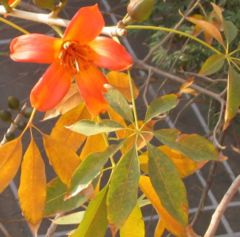Bombax
| Bombax subsp. var. | ||||||||||||||||||||||||||||||||||||||||||||||||||||||||
|---|---|---|---|---|---|---|---|---|---|---|---|---|---|---|---|---|---|---|---|---|---|---|---|---|---|---|---|---|---|---|---|---|---|---|---|---|---|---|---|---|---|---|---|---|---|---|---|---|---|---|---|---|---|---|---|---|

|
|
| ||||||||||||||||||||||||||||||||||||||||||||||||||||||
| ||||||||||||||||||||||||||||||||||||||||||||||||||||||||
| Standard Cyclopedia of Horticulture |
|---|
|
Bombax (a Greek name for raw silk, alluding to the cottony contents of the pods). Bombacaceae. Silk Cotton Tree. A genus of 50 species of tropical shrubs and trees, with digitate 5-9-foliolate lvs., 1-fld. axillary or clustered peduncles, and usually large white or scarlet fls. Specimens are rarely seen in cult, in fine glasshouses, and only 1 of the species appears to be in the American trade. The bark of some species produces commercial fiber such as the Kapok fiber.
|
| Silk-cotton tree {{{status}}} Fossil range: {{{fossil_range}}}
| ||||||||||||||||||||||||||||||||||||||||||||||||||||||||||||||||||
|---|---|---|---|---|---|---|---|---|---|---|---|---|---|---|---|---|---|---|---|---|---|---|---|---|---|---|---|---|---|---|---|---|---|---|---|---|---|---|---|---|---|---|---|---|---|---|---|---|---|---|---|---|---|---|---|---|---|---|---|---|---|---|---|---|---|---|
 Bombax flower | ||||||||||||||||||||||||||||||||||||||||||||||||||||||||||||||||||
| Plant Info | ||||||||||||||||||||||||||||||||||||||||||||||||||||||||||||||||||
| ||||||||||||||||||||||||||||||||||||||||||||||||||||||||||||||||||
| Scientific classification | ||||||||||||||||||||||||||||||||||||||||||||||||||||||||||||||||||
| ||||||||||||||||||||||||||||||||||||||||||||||||||||||||||||||||||
| [[{{{diversity_link}}}|Diversity]] | ||||||||||||||||||||||||||||||||||||||||||||||||||||||||||||||||||
| {{{diversity}}} | ||||||||||||||||||||||||||||||||||||||||||||||||||||||||||||||||||
| Binomial name | ||||||||||||||||||||||||||||||||||||||||||||||||||||||||||||||||||
| {{{binomial}}} | ||||||||||||||||||||||||||||||||||||||||||||||||||||||||||||||||||
| Trinomial name | ||||||||||||||||||||||||||||||||||||||||||||||||||||||||||||||||||
| {{{trinomial}}} | ||||||||||||||||||||||||||||||||||||||||||||||||||||||||||||||||||
| Type Species | ||||||||||||||||||||||||||||||||||||||||||||||||||||||||||||||||||
| {{{type_species}}} | ||||||||||||||||||||||||||||||||||||||||||||||||||||||||||||||||||
| Species | ||||||||||||||||||||||||||||||||||||||||||||||||||||||||||||||||||
| Bombax buonopozense | ||||||||||||||||||||||||||||||||||||||||||||||||||||||||||||||||||
| [[Image:{{{range_map}}}|{{{range_map_width}}}|]] | ||||||||||||||||||||||||||||||||||||||||||||||||||||||||||||||||||
| Synonyms | ||||||||||||||||||||||||||||||||||||||||||||||||||||||||||||||||||
| {{{synonyms}}} |
Bombax is a genus of primarily tropical trees in the mallow family. They are native to tropical areas in western Africa, the Indian Subcontinent, Southeast Asia, as well as sub-tropical regions of East Asia and northern Australia. Common names for the genus include Silk Cotton Tree, Simal, Red Cotton Tree, Kapok and simply Bombax. In China they are known as Mumian (Template:Zh-cp), meaning "tree cotton". Currently three species are recognised, though many plants have been placed in the genus that were later moved.[1]
The genus is most well known though the species B. ceiba, which is widely cultivated throughout tropical and sub-tropcial regions of the world. Furthermore, it is native to both southern and eastern Asia as well as northern Australia. Specimens of trees within the gens are present at many botanical gardens worldwide, such as Lal Bagh in Bangalore. Bombax species are used as food plants by the larvae of some Lepidoptera species including the leaf-miner Bucculatrix crateracma which feeds exclusively on Bombax ceiba.
Description
Bombax species are among the largest trees in their regions, reaching 30 to 40 metres in height and up to 3 metres trunk diameter. The leaves are compound with entire margins and deciduous, being shed in the dry-season. They measure 30 to 50 cm across and are palmate in shape with 5 to 9 leaflets. The calyx is deciduous, meaning it does not persist on the fruits. They bear 5 to 10 cm long red flowers between January and March while the tree is still leafless. The stamens are present in bundles in two whorls, while the staminal column lacks lobes. The ovary matures into a husk containing seeds covered by a fibre similar to that of the kapok (Ceiba pentandra) and to cotton, though with shorter fibres than cotton, that does not lend itself to spinning, making it unusable as a textile product.[2]
References
Further reading
External links
- ↑ 1.0 1.1 "Bombax". Germplasm Resources Information Network - (GRIN). Retrieved on 2007-06-26.
- ↑ Template:Citation